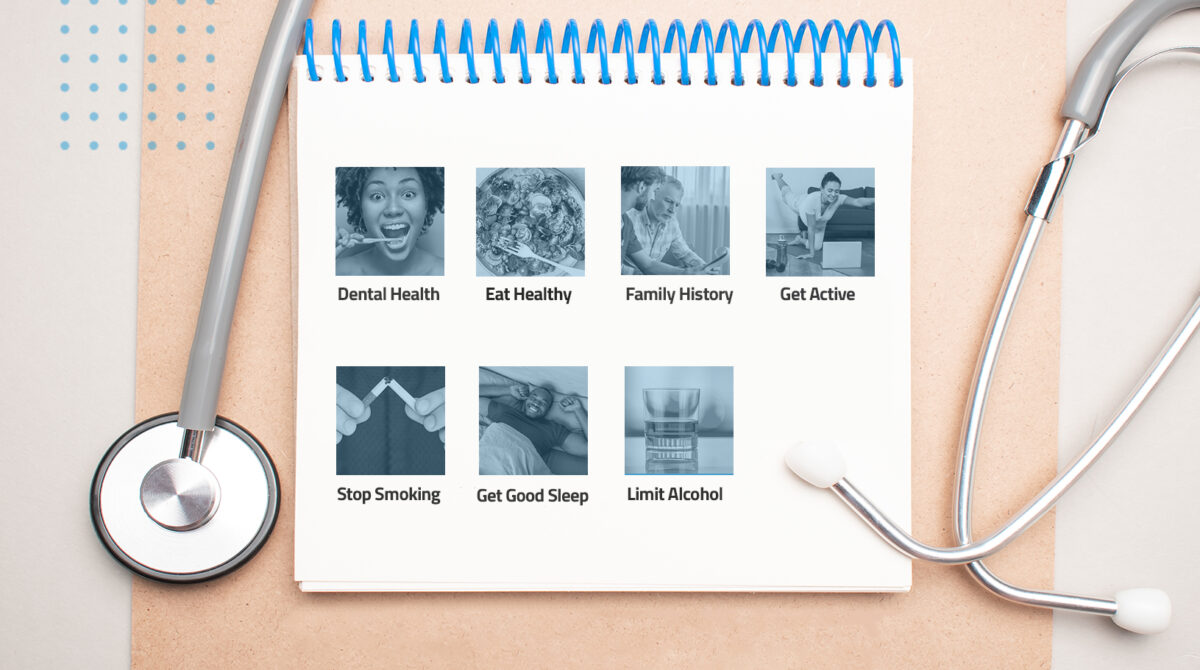
Heart disease and cancer are the leading causes of death. While there is no absolute prevention, adopting healthy habits can significantly reduce your risk of these and other major illnesses.
Many chronic diseases stem from a few key risk factors: tobacco use, poor nutrition, physical inactivity, and excessive alcohol consumption. By steering clear of these risks and prioritizing preventive healthcare, you can greatly enhance your likelihood of maintaining good health, feeling your best, and enjoying a longer life.
Quit Smoking
Quitting smoking is one of the most crucial actions you can take to enhance your health, regardless of your age or how long you’ve been a smoker. The benefits of quitting are significant and immediate, and the encouraging news is that there are effective treatments available to support you in this journey.
Nicotine, a naturally occurring drug in tobacco, is highly addictive, making it challenging for many individuals to stop smoking. However, numerous proven treatments and strategies can assist you in overcoming this addiction. These include nicotine replacement therapies, prescription medications, counseling, and support groups, all of which can significantly increase your chances of successfully quitting. Taking the step to quit smoking not only improves your current health but also reduces your risk of many serious diseases, leading to a longer, healthier life.
Eat Healthy
Maintaining a healthy diet is essential for preventing, delaying, and managing heart disease, type 2 diabetes, and other chronic illnesses. A well-balanced dietary pattern includes a variety of nutrient-dense foods that provide essential vitamins, minerals, and antioxidants.
Key components of a healthy diet are:
- Fruit and Vegetables. Rich in fiber, vitamins, and minerals, these should make up a significant portion of your daily intake.
- Whole Grains. Options like brown rice, quinoa, oats, and whole wheat provide complex carbohydrates and fiber, promoting digestive health and sustained energy levels.
- Lean Protein. Sources such as fish, poultry, beans, and legumes are vital for muscle repair and overall bodily functions.
- Low-Fat Dairy Products. These provide necessary calcium and vitamin D while keeping saturated fat intake low.
It’s also crucial to limit certain dietary components:
- Added Sugars. Excessive sugar intake is linked to obesity, diabetes, and heart disease.
- Saturated Fats. Found in fatty meats and full-fat dairy products, these can increase bad cholesterol levels and heart disease risk.
- Sodium. High sodium intake is associated with hypertension and cardiovascular issues.
Adopting these dietary habits helps maintain a healthy weight, supports bodily functions, and reduces the risk of chronic diseases, contributing to overall well-being and longevity.
Get Regular Physical Activity
Engaging in regular physical activity is vital for preventing, delaying, and managing chronic diseases. It supports cardiovascular health, boosts mental well-being, and enhances overall physical fitness.
Aim for at least 150 minutes of moderate-intensity physical activity each week. Activities such as brisk walking, cycling, swimming, or gardening can significantly improve your heart health and stamina. Additionally, incorporate muscle-strengthening exercises, like weightlifting, resistance band workouts, or body-weight exercises, at least two days a week. These activities help maintain muscle mass, improve bone density, and enhance metabolic function.
By consistently integrating both aerobic and strength-training exercises into your routine, you can effectively reduce the risk of conditions such as heart disease, type 2 diabetes, and obesity. Moreover, regular physical activity improves mood, reduces stress, and boosts energy levels, contributing to a healthier, more vibrant life.
Limit Alcohol
Excessive alcohol consumption over time can lead to numerous serious health issues, including high blood pressure, various cancers, heart disease, stroke, and liver disease. By moderating your alcohol intake, you can significantly lower these health risks.
For men, it’s recommended to limit alcohol to no more than two drinks per day, while women should aim for no more than one drink per day. A standard drink is typically defined as 14 grams of pure alcohol, which equates to approximately 12 ounces of beer, 5 ounces of wine, or 1.5 ounces of distilled spirits.
Reducing alcohol consumption not only helps prevent chronic diseases but also promotes better mental health, improved sleep quality, and enhanced overall well-being. If you find it challenging to limit your alcohol intake, consider seeking support from healthcare professionals or support groups to help manage and reduce your consumption. By making conscious choices about alcohol, you can safeguard your health and improve your quality of life.
Take Care of Your Teeth
Oral diseases, including cavities, gum disease, and oral cancer, affect millions of Americans, causing significant pain and disability. Proper oral hygiene is essential in preventing these issues and maintaining overall health.
To keep your teeth and gums healthy:
- Drink Fluoridated Water. Fluoride helps strengthen tooth enamel and prevent decay.
- Brush Twice a Day with Fluoride Toothpaste. Brushing in the morning and before bed removes plaque and bacteria, reducing the risk of cavities and gum disease.
- Floss Daily. Flossing removes food particles and plaque from between the teeth and along the gumline, areas that a toothbrush can’t reach.
- Visit Your Dentist Annually. Regular dental check-ups are crucial for early detection and treatment of oral health issues. This applies even if you have no natural teeth or use dentures.
By adopting these practices, you can significantly reduce the risk of oral diseases, ensuring a healthier mouth and contributing to your overall well-being. Regular dental care not only prevents pain and discomfort but also supports better systemic health, as oral health is closely linked to conditions like heart disease and diabetes.
Get Enough Sleep
Adequate sleep is crucial for overall health and well-being. Insufficient sleep is associated with the onset and poor management of several chronic conditions, including diabetes, heart disease, obesity, and depression.
Adults should aim for at least 7 hours of quality sleep each night. Consistent, restful sleep helps regulate bodily functions, supports mental health, and boosts the immune system. To improve your sleep quality, establish a regular sleep schedule, create a relaxing bedtime routine, and ensure your sleep environment is comfortable and free from disruptions. Avoiding caffeine and electronic screens before bedtime can also enhance your ability to fall asleep and stay asleep.
Prioritizing sufficient sleep contributes to better health outcomes, improved mood, enhanced cognitive function, and increased energy levels, ultimately leading to a higher quality of life.
Know Your Family History
Understanding your family health history is vital, especially if there is a history of chronic diseases such as cancer, heart disease, diabetes, or osteoporosis. This knowledge can significantly impact your own health, as it may indicate a higher predisposition to these conditions.
Share your family health history with your doctor. With this information, your doctor can guide you on preventive measures, early screenings, and lifestyle modifications to reduce your risk. For instance, they may recommend more frequent screenings, suggest specific dietary and exercise routines, or monitor your health markers more closely.
Being proactive about your family health history enables you to take informed steps to prevent or detect chronic diseases early, ultimately enhancing your ability to manage your health and well-being effectively.
References:
Centers for Disease Control and Prevention. (n.d.). Preventing chronic diseases: What you can do now. Centers for Disease Control and Prevention. https://www.cdc.gov/chronic-disease/prevention/index.html#:~:text=Get%20Regular%20Physical%20Activity,activities%202%20days%20a%20week
Holland, K. (2023, September 25). 10 leading causes of death in the United States. Healthline. https://www.healthline.com/health/leading-causes-of-death
 Schedule Regular Check-Ups. Schedule annual physical exams to help detect health issues early, monitor chronic conditions, and update vaccinations. This will help you to create a personalized health plan and gain helpful preventive care advice from your health care providers..
Schedule Regular Check-Ups. Schedule annual physical exams to help detect health issues early, monitor chronic conditions, and update vaccinations. This will help you to create a personalized health plan and gain helpful preventive care advice from your health care providers..


 The majority of parents adhere to the CDC’s recommended immunization schedule for their children, ensuring protection against 14 potentially severe diseases before the child’s second birthday. Timely vaccination not only shields the vaccinated child but also safeguards those with compromised immune systems who may be vulnerable to illness. By immunizing children as advised, we create a shield of protection not just for them but for the broader community, contributing to public health efforts in preventing the spread of contagious diseases.
The majority of parents adhere to the CDC’s recommended immunization schedule for their children, ensuring protection against 14 potentially severe diseases before the child’s second birthday. Timely vaccination not only shields the vaccinated child but also safeguards those with compromised immune systems who may be vulnerable to illness. By immunizing children as advised, we create a shield of protection not just for them but for the broader community, contributing to public health efforts in preventing the spread of contagious diseases.






